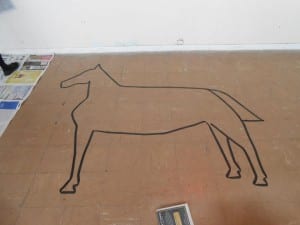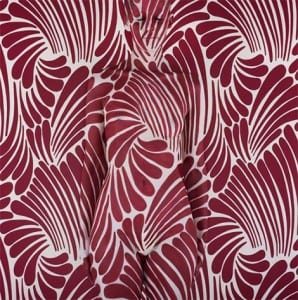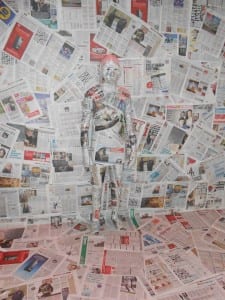In the most recent works of Tim Etchells and company, they ‘always began the performance by building the set, or ended by dismantling them. Always now this work of construction and destruction – letting no thing simply ‘be’- seeing everything instead as a product, as the fruit of some labour, some desire, some ideology.’ ((Etchells, T. (1999) Certain Fragments. Routledge: London p78)) We decided to do something similar, however our performance is going to begin completely set up already, and then following the idea of Tim Etchells of dismantling the set, completely tidy away the whole set and make this part of the performance. We already tear off the newspaper which we will be dressed in, but now we are expanding this to include tearing down the newspaper off the walls and floor, and also to sweep up all the scattered betting slips. So that when we are finished, after all the excitement, there is nothing left. This concept is also echoed in the poem we have chosen to use- ‘the horse that I am riding’ by Ric Bastasa, which ends with the line ‘the horse gets nothing’. We are building up these layers of ‘nothing’ to replicate the sad reality that the Grandstand has been left with nothing.
As the newspaper gets pulled down and is swept away, an outline of a horse made from black duct tape is revealed:

This is similar to the outline of a dead body that would be found at a crime scene, and brings about the idea of death- the death of horse-racing at the Lincoln Racecourse, and the death of the Grandstand as it once was. The performance ends as all the newspaper is packed into boxes and all the tape is pulled up, the projection is turned off and the Grandstand goes back to how it was before we arrived there. This allows the audience to witness the actuality of the current situation of the Grandstand. We want the audience to see the contrast between what this grand building once was, and what it has become today; a ghostly echo of an incredible story. Although the overpowering feeling of loss and deterioration is difficult to shake off, ‘site-related work has become an established practice where an artist’s intervention offers spectators new perspectives upon a particular site or set of sites.’ ((Govan, E. (2007) Making a Performance. Routledge: Oxon and New York p121)) We bring the building to life through our performance; we cover the Grandstand’s walls with newspaper to give it an exciting atmosphere; we echo the past by covering the floor with hundreds of betting slips; we bring back the noise and sounds that may have once resonated through its rooms and grounds.
Another layer we want to add to our piece is the recent horse meat scandal that has hit TESCO. A few months ago at the time of the scandal, the Independent reported the following: “Horsemeat has been discovered in beefburgers sold by the supermarket giants Tesco and Iceland, it emerged tonight. Investigators said that in Tesco’s Everyday Value burgers, horsemeat accounted for almost one third of the meat content.” ((Masters, S. (2013) The Independent. Online: http://www.independent.co.uk/life-style/food-and-drink/news/horsemeat-discovered-in-beefburgers-on-sale-at-tesco-and-iceland-8453040.html)) As this has been all over the news recently, we thought it would create a small moment of dark humour within the piece. We only want to touch on it slightly as it’s not strictly specific to our site, so we plan to get some mincemeat from Tesco and have it placed on a plate, with the Tesco label below it. After we have swept the newspaper across the floor to reveal the outline of the horse, we will announce to the audience the Lincolnshire Handicap winner of 2013 and present to them the plate of mincemeat.

